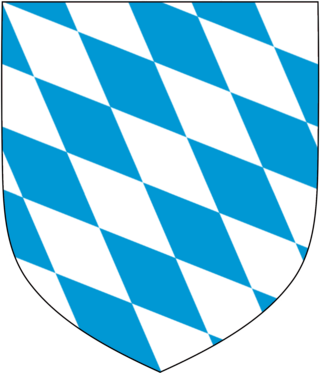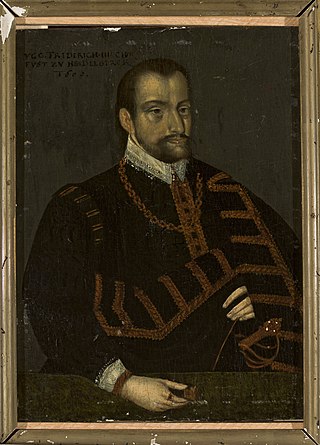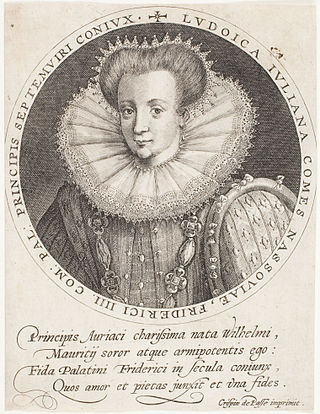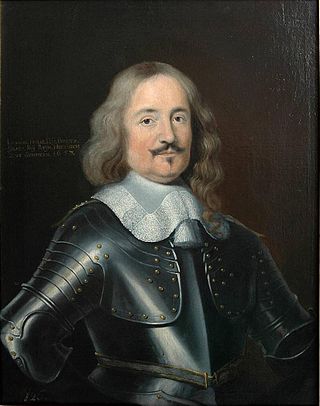
Rupert of the Palatinate, sometimes known as Robert of the Palatinate, a member of the House of Wittelsbach, was Elector Palatine from 1398 and King of Germany from 1400 until his death.

The Electoral Palatinate or the Palatinate, officially the Electorate of the Palatinate, was a state that was part of the Holy Roman Empire. The electorate had its origins under the rulership of the Counts Palatine of Lotharingia in 915; it was then restructured under the Counts Palatine of the Rhine in 1085. From 1214 until the Electoral Palatinate was merged into the Kingdom of Bavaria in 1805, the House of Wittelsbach provided the Counts Palatine or Electors. These counts palatine of the Rhine would serve as prince-electors from "time immemorial", and were noted as such in a papal letter of 1261; they were confirmed as electors by the Golden Bull of 1356.

The House of Wittelsbach is a former Bavarian dynasty, with branches that have ruled over territories including the Electorate of Bavaria, the Electoral Palatinate, the Electorate of Cologne, Holland, Zeeland, Sweden, Denmark, Norway, Hungary, Bohemia, and Greece. Their ancestral lands of Bavaria and the Palatinate were prince-electorates, and the family had three of its members elected emperors and kings of the Holy Roman Empire. They ruled over the Kingdom of Bavaria which was created in 1805 and continued to exist until 1918.

John Casimir, Count Palatine of Simmern was a German prince and a younger son of Frederick III, Elector Palatine. A firm Calvinist, he was a leader of mercenary troops in the religious wars of the time, including the Dutch Revolt. From 1583–1592 he acted as regent for his nephew, Elector Palatine Frederick IV.

Frederick IV, Elector Palatine of the Rhine, only surviving son of Louis VI, Elector Palatine and Elisabeth of Hesse, called "Frederick the Righteous".
Palatinate or county palatine may refer to:

Stephen of Simmern-Zweibrücken was Count Palatine of Simmern and Zweibrücken from 1410 until his death in 1459.

The House of Palatinate-Simmern was a German-Bavarian cadet branch of the House of Wittelsbach. The house was one of the collateral lineages of the Palatinate. It became the main branch in 1559.

The Duchy of Palatinate-Zweibrücken was a duchy of the Holy Roman Empire with full voting rights to the Reichstag. Its capital was Zweibrücken. The reigning house, a branch of the Wittelsbach dynasty, was also the Royal House of Sweden from 1654 to 1720.

The County Palatine of Veldenz was a principality in the contemporary Land Rhineland-Palatinate with full voting rights to the Reichstag. The county was located partially between Kaiserslautern, Sponheim and Zweibrücken, partially on the Mosel in the Archbishopric of Trier. A municipality of the same name, Veldenz, and a castle, Schloss Veldenz, are located in the district of Bernkastel-Wittlich.

Louis VI, Elector Palatine, was an Elector from the Palatinate-Simmern branch of the house of Wittelsbach. He was the first-born son of Frederick III, Elector Palatine and Marie of Brandenburg-Kulmbach.

Louise Juliana of Orange-Nassau was a countess consort of the Palatinate by marriage to Frederick IV, Elector Palatine, and took part in the regency government of her son between 1610 and 1614. She also acted as a mediator between the king of Sweden and the elector of Brandenburg in 1631.

Princess Anna of Sweden, also known as Anna Maria and Anne Marie, was a Countess Palatine consort of Veldenz by marriage to George John I, Count Palatine of Veldenz. She served as Interim Regent from 1592 to 1598, and supervised the partition of the territories between her sons. She was the daughter of King Gustav I of Sweden and Queen Margaret.
Palatinate-Simmern and Zweibrücken was a state of the Holy Roman Empire based in the Simmern and Zweibrücken in modern Rhineland-Palatinate, Germany.

Louis Philip was the Count Palatine of Simmern-Kaiserslautern from 1610 until 1655. Philip acted as Administrator of the Palatinate between 1632 and 1648.
Louis Henry was the Count Palatine of Simmern-Kaiserslautern from 1653 until 1673.
The district duchy, also known as the district principality, was a type of the state under the patrimonial system, such as duchy or principality, formed in the feudal system, as a result of land partition between the members of a royal family. It occurred in the Middle Ages and early modern period, notably in Europe, in states such as the Holy Roman Empire, Duchy of Poland, and Kievan Rus'.

Maria of Nassau or Maria of Orange-Nassau was a Dutch princess of the house of Orange and by marriage pfalzgräfin or countess of Simmern-Kaiserslautern.
Marie Eleonore von Brandenburg (1607-1675) was a princess of Brandenburg, Countess Palatine and from 1655 to 1658, regent of Simmern.